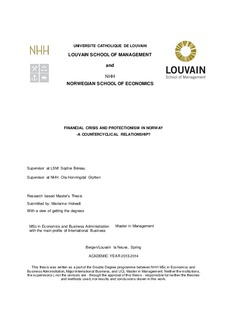Financial crisis and protectionism in Norway : a countercyclical relationship?
Master thesis
Permanent lenke
http://hdl.handle.net/11250/218626Utgivelsesdato
2014Metadata
Vis full innførselSamlinger
- Master Thesis [4372]
Sammendrag
The present dissertation intends to explain the overall research question: “how and why does a financial crisis affect the average level of protectionism in Norway?” Ad valorem equivalent (AVE) tariffs in Norway are investigated between 1866 and 2012, covering six financial crisis.
Cycle values measured as deviations from (Hodrick and Prescott filtered) trend are used to discover and compare AVE in normal times versus AVE during financial crisis. The relationship between AVE and various macroeconomic variables from the theory of endogenous protection is inspected, with the OLS technique, to understand variation in the AVE rate over time.
Protectionism in Norway is found to often move countercyclically to financial crises. The AVE rate deviated negatively before and positively during and right after four of the financial crisis in Norway. However, a causal relationship is not confirmed in the OLS model.
These deviations from trend, as well as yearly percentage changes in the AVE rate, are largely a result of Norway following the great powers. The United States’ AVE rate has the highest explanatory power and is the only significant variable that creates positive deviations from trend during a financial crisis. The unemployment rate also generates positive deviations from AVE-trend. As opposed to theoretical expectations, an increase in import penetration decreases the average AVE rate.
Evidence of a countercyclical relationship between a financial crisis and the AVE rate is, however, mainly a pre-General Agreement on Tariffs and Trade (GATT) phenomenon. The introduction of GATT sharply reduced the actual AVE rate in Norway. It also changed how AVE responded to the, above mentioned, macroeconomic variables. Of those, inflation is the only significant variable in the post-GATT scenario and was found to explain why the AVE rate deviated positively from trend during the Banking Crisis.
